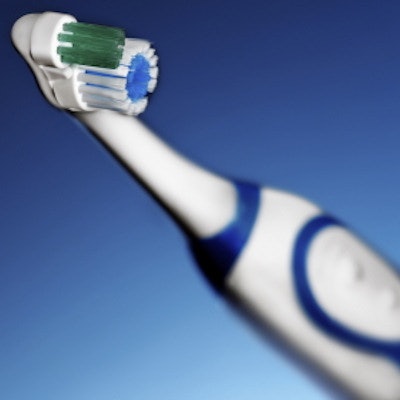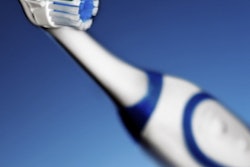
For patients who can't decide between a manual and powered toothbrush, a hybrid design that combines both modes may be ideal. But how effective is such a product at reducing plaque compared with a regular powered toothbrush, and how much do users like it? To learn more, researchers investigated.
They asked individuals who had never used a powered toothbrush to brush with a hybrid that included manual, powered sonic, and combined modes and found that the results were similar.
"The results of this one-time use trial demonstrate that the hybrid toothbrush (used in the combined mode) is as good as a marketed oscillating-rotating toothbrush for plaque removal," wrote the authors, led by D. Klonowicz of Dermscan Poland in Gdansk (BMC Oral Health, November 6, 2018).
Combined approaches
Hybrid toothbrushes, a fairly recent addition to the roster of powered toothbrushes, initially were designed for orthodontic patients and individuals with limited motor skills, the authors noted. Hybrid simply means that the toothbrush can be used either in manual mode (motor off), in powered mode (sonic), or in combined mode (manual gesture associated with sonic vibrations).
Researchers wanted to compare the efficacy, as well as user tolerance and acceptance, of the Elgydium Clinic/Inava Hybrid toothbrush (Pierre Fabre Oral Care) using the combined mode with an oscillating-rotating powered toothbrush (Oral-B Vitality 2D Sensitive Clean, Procter & Gamble).
“We hypothesize that such an individualized approach can favor long-term compliance with oral health recommendations and improve global oral wellness.”
The hybrid toothbrush looks like a manual toothbrush with a traditional oval brush head. The sonic mode uses vibration technology to produce side-to-side movements of up to 28,000 strokes per minute. The oscillating-rotating toothbrush has a small, circular brush head that produces 7,600 oscillations per minute.
The researchers recruited 66 study participants with at least 20 natural teeth to use one of the toothbrushes in the laboratory. Participants were between the ages of 18 and 70 and had never used an electric toothbrush. Participants were instructed not to perform any oral hygiene behaviors for 24 hours or to eat, drink, or smoke for four hours beforehand.
To be included in the study, participants needed to have a Silness and Löe Plaque Index between 1.0 and 2.0 and Modified Gingival Index between 1.0 and 2.0. They underwent exams before and after brushing to assess clinical signs, such as ulceration and bleeding, and functional signs, such as pruritus and pain, on soft and hard tissues. The investigators scored each sign from 0 (none) to 3 (moderate), and provided a global tolerance assessment for each subject.
They randomized 66 participants to use one of the toothbrushes (33 to each group) for two minutes while being observed and provided instructions on using their assigned toothbrush. For the hybrid brush, this called for using the combined mode with the brush bristles contacting teeth at a 45° angle from the gums and while applying slight pressure by slowly moving the brush head with a light circular motion.
After this one-time use, all users of both toothbrushes experienced significant decreases in their plaque index scores (see table below).
| Reduction in mean plaque index after one-time brushing with oscillating-rotating powered or hybrid toothbrushes | ||
| Oscillating-rotating | Hybrid | |
| Global score | 43% (p < 0.0001) | 45% (p < 0.0001) |
| Labial side | 52% (p < 0.0001) | 53% (p < 0.0001) |
| Lingual side | 34% (p < 0.0001) | 37% (p < 0.0001) |
Twelve hybrid users experienced very mild to mild bleeding, as did 14 who used the oscillating-rotating toothbrush. This could be linked to their using the devices for the first time or brushing too intensively since they were being observed, the authors wrote. The dentist who examined the participants judged the global tolerance of both toothbrushes as "good."
Of the hybrid users, 91% said the intensity of the toothbrush's vibrations felt just about right, as did 94% of the oscillating-rotating users. In addition, 87% of the hybrid users judged that toothbrush as better than their usual manual one, as did 90% who used the oscillating-rotating one.
The authors noted that advantages of the hybrid toothbrush include its lack of a bulky electrical base and its relatively light weight, which can be helpful for children or elderly people. Also, the brush is gentle and can be beneficial for those with gum sensitivities, they wrote.
Gingival information limited
While the authors listed no study limitations, they noted that longer-term studies are needed to learn more about the effects of the hybrid toothbrush on gingival health. For now, they acknowledged that the hybrid offers the flexibility of three different modes that can be adjusted to preferences, skills, or mouth condition.
"We hypothesize that such an individualized approach can favor long-term compliance with oral health recommendations and improve global oral wellness," the authors concluded.
Study disclosures
The researchers noted that Pierre Fabre Oral Care provided funding for the study design, writing, and data collection, analysis, and interpretation.



















